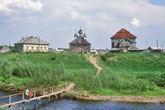Enduring traditions in the Arkhangelsk Region
All photos by William Brumfield
The past century has witnessed the loss of much of Russia's wooden architectural heritage, yet remarkable monuments remain, particularly in regions of the historic Russian North.
Two very distinctive examples are located at opposite ends of the port of Arkhangelsk: the Church of St. Nicholas at the village of Liavlia, on the high right bank of the Northern Dvina; and the Church of the Intercession at the village of Zaostrovye, located among the islands of the extended Dvina River delta to the northwest.
The village of Liavlia is situated near the confluence of the small Liavlia River with the Dvina. Because of persistent erosion of the riverbanks, the inhabitants of Liavlia eventually retreated to the neighboring village of Khorkovo, which serves as the alternative official name of the settlement. Fortunately, the local Orthodox churches were built on an elevated, unassailable location, which has contributed to their preservation. Liavlia boasts one of the oldest log structures in the Russian North.
Thanks to its ancient trading ties to the medieval commercial city of Novgorod, Liavlia became the site of a monastery dedicated to the Dormition of the Virgin in the 14th century. In 1339, Grand Prince Ivan Kalita, wishing to extend Moscow's influence in the area, commissioned for the monastery a manuscript of the Gospels that is one of the earliest Russian parchment works. When the Liavlia monastery was subordinated in 1633 to the larger Monastery of Saint Antony Siisky – located on the opposite side of the Dvina – the manuscript was transferred there. Known as the Siisky Gospels, it is now a treasure of the Academy of Sciences Library in St. Petersburg.
In the 16th century, the Liavlia monastery contained two wooden churches, the Dormition and St. Nicholas. A fire in 1580 led to the building of a new log Church of the Dormition, whose archaic form survives as a rare example of a church designed from the ground up as an octagonal tower. Usually the octagonal tower rests over a cuboid base.
The massive log tower rises to an elevated "tent" crown supporting a large cupola. The east and west sides have extensions for the apse and vestibule, crowned with barrel gables. The west end originally had an elevated, cantilevered porch that enclosed the main entrance.
How to get there
Take a train to Arkhangelsk and than a bus to Khorkovo or Bobrovo
Converted to a parish church in 1765 after the closure of the Liavlia monastery, the Domition Church was shuttered in 1805 because of structural decay. A brick Church of the Dormition had already been built nearby in 1804 to serve the parish. That might have meant the ultimate demise of the log church. But in 1844, the governor-general of Arkhangelsk, Marquis Alexander de Traversay (1780-1850), visited the village and decided to restore the massive log structure. Although this was a remarkably noble gesture, the crude approach to "preservation" meant that about seven feet of decaying logs at the base were simply discarded and the remaining part of the octagonal church reassembled. Originally, the imposing tower would have been eight feet higher.
In 1845, the restored structure was reconsecrated as the Church of St. Nicholas, the name that it bears to this day. The church was later encased in painted plank siding, and its "tent" tower was covered with tin roofing. During the Soviet era, the durable structure was put to a number of uses, including a garrison club.
In the late 1960s, a careful restoration removed the planks and metal sheathing, rebuilt the cupola and placed the original cupola frame – a unique example of archaic log design – within the church as a museum display. Practical considerations did not allow for a reconstruction of the original tower height. In the 1970s the St. Nicholas church was affiliated with the adjacent Malye Korely outdoor museum of wooden architecture. The parish worships in the restored brick Dormition Church.
The opposite, northwestern end of Arkhangelsk is marked by marshy, deltaic terrain with shifting river channels. One of the larger islands in this area is itself bisected by the Zaostrovka River and is known as Zaostrovye ("over the island"). This land, nourished by frequent flooding, is the site of another pairing of log and brick churches near the village of Rikasovo.
As at Liavlia, the wooden church is the dominant and idiosyncratic form, with its tent tower and nine cupolas. Over the centuries, a number of wooden churches existed at the village. In 1683, the parish was permitted to build a new church dedicated to the Purification, with secondary altars to Sts. Peter and Paul and the martyrs Florus and Laurus.
The form of the Zaostrovye church was highly distinctive, with a central tent tower and cupola. The base of the tower was defined by eight wooden cupolas on high drums. The roof had a flowing gable line.
In 1808 work began on a brick Church of the Purification, which replaced the wooden structure as the parish church. The wooden church, closed for decades, was repaired and reconsecrated in 1864 as the Church of the Intercession of the Virgin. Over the next half century its highly original form was modified and disfigured.
Closed during the Soviet period, the Church of the Purification/Intercession was the object of major work in the late 1960s that restored much of its earlier form. Even so, the work was never completed, and necessary maintenance has been neglected. The parish uses the reopened masonry church, whose traditional white form is crowned with five cupolas.
Life continues in its seasonal routines for the inhabitants of the Dvina villages. Each spring the low banks are slightly eroded, but the wooden houses and their gardens cling to existence, with an occasional church among them. Small ferries slowly ply among island stations (usually a shed at a plank dock), taking people to the city and back. Despite the primitive conditions and harsh climate, the island villages are testimony to the enduring power of the river that sustains them.
All rights reserved by Rossiyskaya Gazeta.
Subscribe
to our newsletter!
Get the week's best stories straight to your inbox


